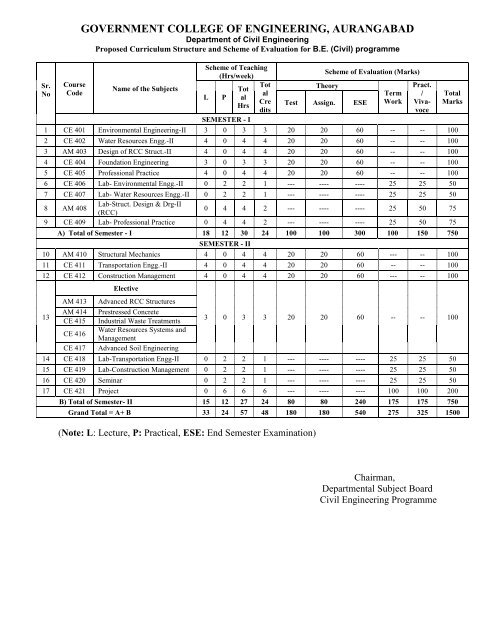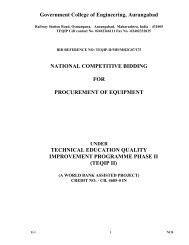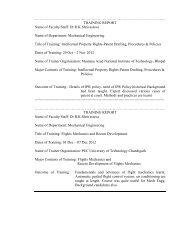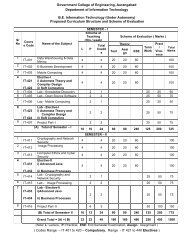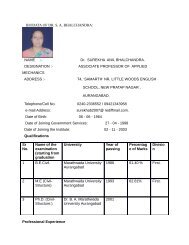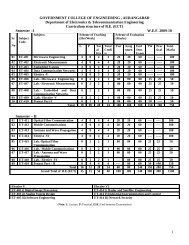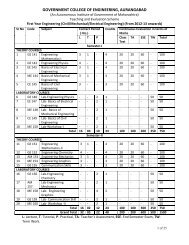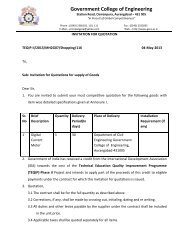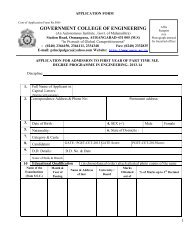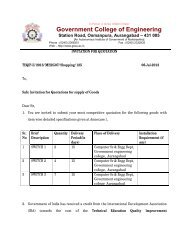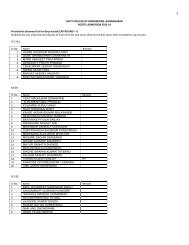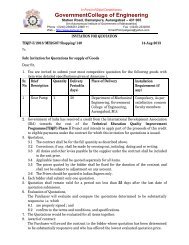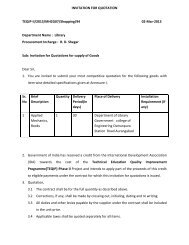Civil - Government College Of Engineering Aurangabad
Civil - Government College Of Engineering Aurangabad
Civil - Government College Of Engineering Aurangabad
You also want an ePaper? Increase the reach of your titles
YUMPU automatically turns print PDFs into web optimized ePapers that Google loves.
Sr.<br />
No<br />
Course<br />
Code<br />
GOVERNMENT COLLEGE OF ENGINEERING, AURANGABAD<br />
Department of <strong>Civil</strong> <strong>Engineering</strong><br />
Proposed Curriculum Structure and Scheme of Evaluation for B.E. (<strong>Civil</strong>) programme<br />
Name of the Subjects<br />
Scheme of Teaching<br />
(Hrs/week)<br />
Tot<br />
Tot<br />
al<br />
L P al<br />
Cre<br />
Hrs<br />
dits<br />
Scheme of Evaluation (Marks)<br />
Theory<br />
Test Assign. ESE<br />
Term<br />
Work<br />
SEMESTER - I<br />
1 CE 401 Environmental <strong>Engineering</strong>-II 3 0 3 3 20 20 60 -- -- 100<br />
2 CE 402 Water Resources Engg.-II 4 0 4 4 20 20 60 -- -- 100<br />
3 AM 403 Design of RCC Struct.-II 4 0 4 4 20 20 60 -- -- 100<br />
4 CE 404 Foundation <strong>Engineering</strong> 3 0 3 3 20 20 60 -- -- 100<br />
5 CE 405 Professional Practice 4 0 4 4 20 20 60 -- -- 100<br />
6 CE 406 Lab- Environmental Engg.-II 0 2 2 1 --- ---- ---- 25 25 50<br />
7 CE 407 Lab- Water Resources Engg.-II 0 2 2 1 --- ---- ---- 25 25 50<br />
8 AM 408<br />
Lab-Struct. Design & Drg-II<br />
(RCC)<br />
0 4 4 2 --- ---- ---- 25 50 75<br />
9 CE 409 Lab- Professional Practice 0 4 4 2 --- ---- ---- 25 50 75<br />
Pract.<br />
/<br />
Vivavoce<br />
A) Total of Semester - I 18 12 30 24 100 100 300 100 150 750<br />
SEMESTER - II<br />
10 AM 410 Structural Mechanics 4 0 4 4 20 20 60 --- -- 100<br />
11 CE 411 Transportation Engg.-II 4 0 4 4 20 20 60 -- -- 100<br />
12 CE 412 Construction Management 4 0 4 4 20 20 60 --- -- 100<br />
13<br />
AM 413<br />
AM 414<br />
CE 415<br />
CE 416<br />
CE 417<br />
Elective<br />
Advanced RCC Structures<br />
Prestressed Concrete<br />
Industrial Waste Treatments<br />
Water Resources Systems and<br />
Management<br />
Advanced Soil <strong>Engineering</strong><br />
Total<br />
Marks<br />
3 0 3 3 20 20 60 -- -- 100<br />
14 CE 418 Lab-Transportation Engg-II 0 2 2 1 --- ---- ---- 25 25 50<br />
15 CE 419 Lab-Construction Management 0 2 2 1 --- ---- ---- 25 25 50<br />
16 CE 420 Seminar 0 2 2 1 --- ---- ---- 25 25 50<br />
17 CE 421 Project 0 6 6 6 --- ---- ---- 100 100 200<br />
B) Total of Semester- II 15 12 27 24 80 80 240 175 175 750<br />
Grand Total = A+ B 33 24 57 48 180 180 540 275 325 1500<br />
(Note: L: Lecture, P: Practical, ESE: End Semester Examination)<br />
Chairman,<br />
Departmental Subject Board<br />
<strong>Civil</strong> <strong>Engineering</strong> Programme
CE-401 Environmental <strong>Engineering</strong>-II<br />
Teaching Scheme:<br />
Lectures: 3 Hrs / Week<br />
Examination scheme:<br />
Test: 20 marks<br />
Assignment:20 marks<br />
ESE :60 marks<br />
UNIT I:<br />
Types of Sewage and Types of Sewerage systems, Estimation of Sewage Discharge, Variation in<br />
sewage flow, The Run off Process and Computing the Peak Drainage Discharge, Maximum and<br />
Minimum velocities to be generated in sewers, Hydraulic Characteristics of Circular Sewer<br />
sections and use of Nomograms<br />
UNIT II:<br />
Forces acting on Sewer Pipes, Sewer materials and Jointing, Laying of sewer pipes, Sewer<br />
Appurtenances, Decomposition of Sewage by aerobic and anaerobic processes, Characteristics of<br />
sewage and comparison of the same with other types of industrial wastewaters, effects of<br />
different parameters on environment<br />
UNIT III:<br />
Kinetics of BOD, Oxygen Sag Curve and self purification of streams, BIS standards for<br />
Discharge of sewage and Industrial wastewaters, Classification of Treatment Processes, Design<br />
concepts of Primary treatment units<br />
UNIT IV:<br />
Secondary treatment units-Activated Sludge Process, Trickling Filters, Stabilization Ponds,<br />
Septic Tanks, UASB Reactors, Anaerobic Filters, Tertiary Treatment Units, Flow Diagrams of<br />
Treatment units,<br />
UNIT V:<br />
Definition, Classification, Quantity and Composition of Refuse; Disposal of Refuse by various<br />
methods- Sanitary land filling, Burning or Incineration, Pulverization and Composting, Excreta<br />
Disposal in Non sewered and Rural Areas; Functions and Types of Traps used in Sanitary<br />
Plumbing Systems, Systems of Plumbing<br />
Reference Books:<br />
1) Metcalf & Eddy, Wastewater <strong>Engineering</strong> Treatment and Reuse, Tata McGraw-Hill<br />
Publishing Company Limited, New Delhi<br />
2) S.K.Garg, Sewage Disposal and Air Pollution <strong>Engineering</strong>, Khanna Publishers, New<br />
Delhi<br />
3) G.S.Birdie & J.S.Birdie, Water Supply and Sanitary <strong>Engineering</strong>, Dhanpat Rai Publishing<br />
Company, New Delhi<br />
******
CE 402: Water Resources <strong>Engineering</strong> – II<br />
Teaching Scheme:<br />
Lectures: 4 Hrs/ Week<br />
Examination scheme:<br />
Test: 20 marks<br />
Assignment:20 marks<br />
ESE :60 marks<br />
UNIT I:<br />
Reservoir Planning and Gravity Dam<br />
Reservoir types, classification of dam, investigation of site and selection, storage capacity<br />
estimation, fixing various control levels, Gravity Dam: forces acting, modes of failure, stability<br />
analysis, design of low and high gravity dams, galleries, joints, keys and water seals.<br />
UNIT II:<br />
Earth, Arch and Buttress Dam<br />
Types of earth dam, components and their functions, causes of failure, design criteria, stability<br />
analysis, seepage and its control through earth dam and its foundation, drainage of earth dam,<br />
Arch and Buttress Dam: types and suitability, forces acting and design methods of arch dams,<br />
buttress dam and types of buttress dam<br />
UNIT III:<br />
Spillways and Canal<br />
Types of spillways, construction features, design criteria, energy dissipation, spillway gates,<br />
canal: classification, factors influencing alignment, design of canal in non alluvial soils,<br />
Kennedy’s and Lacey’s silt theories<br />
UNIT IV:<br />
Canal Masonry Works<br />
Types of cross drainage works, components and hydraulic design, design of transition. Canal<br />
falls: necessity, location, types, and design, energy dissipation, Head and cross regulators,<br />
construction features and hydraulic design, Modules: function, requirements, types and hydraulic<br />
design<br />
UNIT V:<br />
Diversion Weir Head Works, Dam outlets and intakes<br />
Components of diversion weir head works, design criteria, Design of weir by Bligh and Khoslas<br />
theory, Dam outlets and intakes: types, construction features, and design principles<br />
Reference Books:<br />
1. Garg, S.K. “Irrigation engineering and hydraulic structures”, Khanna Publishers, Delhi<br />
2. Punmia, B.C. and Pande, B.B.L. “Irrigation and water power engineering”, Laxmi<br />
Publications Pvt. Ltd, New Delhi<br />
3. Modi, P.N. “Irrigation water resources and water power engineering”, Standard Book<br />
House, Delhi<br />
4. Wurbs, R.A. and James, W.P. “Water Resources <strong>Engineering</strong>”, Prentice Hall of India Pvt.<br />
Ltd, New Delhi<br />
*****
Teaching Scheme:<br />
Lectures: 4 Hrs/ Week<br />
AM 403: Design of RCC Structures-II<br />
Examination scheme:<br />
Test: 20 marks<br />
Assignment:20 marks<br />
ESE :60 marks<br />
UNIT I:<br />
Multistory Buildings<br />
Structure: Structural systems, Stiffening elements, Regularity, Member stiffness; Loads: Dead,<br />
Live, Wind, Earthquake; Analysis & Design: Frames- Vertical loads, Lateral loads; Torsion in<br />
buildings; Monolithic joints; Foundations- Combined footings, Raft, Piles;<br />
UNIT II:<br />
Torsion in RCC Members<br />
Typical failure modes; Torsional stiffness of homogeneous, RCC sections: Equivalent bending<br />
moment, shearing force; Provision of reinforcement;<br />
UNIT III:<br />
Circular slabs<br />
Types: Simply supported slabs, Fully restraint slabs, Simply supported slabs with a concentric<br />
hole; Loads: Uniformly distributed loads, concentric loads, uniformly distributed loads inside a<br />
concentric circle, linearly varying distributed load; Analysis & Design: Examples<br />
UNIT IV:<br />
Retaining Walls<br />
Types: Cantilever, Counter fort; Preliminary sizes; Loads: Forces acting on retaining walls;<br />
Stability requirements; Analysis & Design: Examples<br />
UNIT V:<br />
Prestressed Concrete<br />
Basic concepts, properties of materials, classification and types of prestressing, prestressing<br />
systems, end anchorages, losses of prestress, analysis of beams for flexure, pressure line, kern<br />
distances, efficiency of section, Magnel’s method, shear and diagonal tension, stresses at<br />
anchorage, IS: 1343-1980 recommendations, Limit state design procedure for flexure.<br />
Reference Books:<br />
1. Ashok K. Jain, Reinforced Concrete (Limit State Design), Nem Chand & Brothers,<br />
Roorkee, Latest Edition<br />
2. P. C. Varghese, Advanced Reinforced Concrete Design, Prentice Hall, New Delhi,<br />
3. S. Unnikrishna Pillai & Devdas Menon, Reinforced Concrete Design, Tata McGraw-Hill<br />
Publishing Company, New Delhi, Latest Edition<br />
4. N. Krishna Raju, Advanced Reinforced Concrete Design, CBS Publishers New Delhi, B.<br />
C. Punmia, Ashok Kumar Jain, Arun Kumar Jain, Comprehensive Designs, Laxmi<br />
Publications (P) Ltd, New Delhi, Latest Edition<br />
5. N. Krishna Raju, Prestressed Concrete, Tata McGraw Hill Publishing Company Ltd.,<br />
6. Lin T.Y. and Burns N.H., Design of Prestressed Concrete Structures, John Wiley and<br />
Sons Inc., New York.<br />
7. IS:456-2000, Plain and Reinforced Concrete-Code of Practice (Fourth Revision), Bureau<br />
of Indian Standards, New Delhi.<br />
8. IS: 875-1987(Parts 1-5), Code of Practice for Design Loads (other than earthquake) for<br />
Buildings and Structures (Second Revision)<br />
9. IS: 1343- 1980, Code of Practice for Prestressed Concrete, Bureau of Indian Standards,<br />
New Delhi.<br />
*****
CE 404: Foundation <strong>Engineering</strong><br />
Teaching Scheme:<br />
Lectures: 3 Hrs/ Week<br />
Examination scheme:<br />
Test: 20 marks<br />
Assignment:20 marks<br />
ESE :60 marks<br />
UNIT I:<br />
Site investigation and sub soil exploration, bearing capacity:<br />
Open excavation, boring, subsurface sounding, and geophysical methods Theories of Terzaghi,<br />
Prandalts, Meyer off for bearing capacity, Ultimate, net and safe bearing capacity, Local and<br />
general shear failure, Plate load test and its limitations, Standard penetration test Effect of water<br />
table and eccentricity of loading on bearing capacity<br />
UNIT II:<br />
Settlement analysis and Design of footing:<br />
Causes and control of settlement, Immediate, consolidation and differential settlement, Design<br />
considerations and construction of different types of footings. Proportioning of footings.<br />
UNIT III:<br />
Pile foundation, Raft foundation:<br />
Types of pile foundation, their use and function, negative skin friction Group action, number and<br />
spacing of piles, under rimed pile foundation Design considerations and construction of different<br />
types of raft foundation<br />
UNIT IV:<br />
Cofferdam, Well and Cassions:<br />
Types of sheet piles, Cofferdam uses and features. Types of well, component part, choice of<br />
particular type, sinking, tilting Types of caissons, safety problems, caisson disease<br />
UNIT V:<br />
Foundation on black cotton soil<br />
Characteristics of black cotton soil, problems, foundation techniques, dewatering of foundation,<br />
foundation for towers and tanks<br />
Reference books:<br />
1. V.N.S.Murthy, “Soil mechanics and foundation engineering”Vol.1, Saikrupa Technical<br />
Consultants, Bangalore, Latest edition.<br />
2. Punmia B. C. “Soil mechanics and foundation engineering ”Laxmi Publications Pvt. Ltd.,<br />
New Delhi, Latest edition.<br />
3. J.E.Bowles, Foundation analysis and design, McGraw Hill International ed. New York<br />
4. Wayne C. Teng, “Foundation Design” Prentice Hall of India, New Delhi<br />
5. K.R. Arora, “Soil Mechanics and Foundation <strong>Engineering</strong>” Standard Publishers<br />
Distributors<br />
6. Kasmalkar B. J. “Geotechnical <strong>Engineering</strong>”, Pune Vidyarthi Griha Prakashana,Sadashiv<br />
Peth Pune-30, Latest edition.<br />
7. Shashi K. Gulhati and Manoj Datta, “Geotechnical <strong>Engineering</strong>”Tata McGraw Hill<br />
Publication, Latest edition.<br />
8. T.W. Lambe, Soil Testing for Engineers, John Wiley Publication<br />
*****
Teaching Scheme:<br />
Lectures: 4 Hrs/ Week<br />
CE 405: Professional Practice<br />
Examination scheme:<br />
Test: 20 marks<br />
Assignment:20 marks<br />
ESE :60 marks<br />
UNIT I:<br />
Introduction of IS: 1200 for modes of measurement. Estimating: Definition, importance of<br />
quantity surveying for civil engineer, purpose, types of estimates, data required for estimates.<br />
Item of work, description of an item work, units of measurement and principles deciding the<br />
units, I.S. & PWD mode of measurements of building. Definition and purpose of approximate<br />
estimate, methods of approximate estimating of building and other projects e.g. roads, irrigation<br />
& water supply and sewerage schemes.<br />
UNIT II:<br />
Taking out Quantities Principles, methods of taking out quantities for different assignments<br />
mentioned in term work, Abstracting bill of quantities, provisional and prime cost items,<br />
contingencies, establishment charges.<br />
UNIT III:<br />
Analysis of Rates : Factors affecting cost an item of work materials, labour, tools, and plant,<br />
overheads and profit. Task work-definition and factors affecting task work Transportation of<br />
material and cost Schedule of materials and labour, schedule of rates (D.S.R). Analysis of rates<br />
of different items mentioned in T.W. Specifications : Definition and purpose, types, drafting<br />
specifications, legal aspect, specifications of stone masonry, wood work, earth work, reinforcing<br />
brick work of R.C.C. work.<br />
UNIT IV:<br />
Valuation of Property: Purpose, nature of value, price, factors affecting value of a property. Free<br />
hold and leasehold property. Depreciation and methods of working out depreciation, sinking<br />
fund, years purchase, out goings. Methods of valuation<br />
Land and building basis, Rental basis, Reproduction and replacement cost basis, Profit basis,<br />
fixation of rent.<br />
UNIT V:<br />
Contracts and Tenders: Types of contracts, Law of contract, essentials of contract conditions.<br />
Liquidated damages defect liability period, retention money, termination of contract, payment,<br />
secure advance.<br />
Tenders and tender Notice: Prequalification, Technical Bid/Price Bid, Opening of the tender.<br />
Tender, Types of tenders, tender notice, documents, methods of preparation and submission of<br />
tenders, scrutiny of tenders, acceptance of tenders, BOT Tender, general idea of global tenders.<br />
Administrative approval, technical sanction,<br />
Text Books<br />
1. Chakraborti M., .Estimating ,Costing and Specification in <strong>Civil</strong> <strong>Engineering</strong>,<br />
2. Dutta B.N., Estimating and costing ,<br />
3. Patil B.S., <strong>Civil</strong> <strong>Engineering</strong> Contracts and Estimates,<br />
Reference Books<br />
1. PWD Hand Book and Red Book<br />
2. PWD District Schedule of Rates (DSR)<br />
*****
CE 406: Lab Environmental <strong>Engineering</strong>-II<br />
Teaching scheme:<br />
Practicals : 2 Hrs /Week<br />
Examination scheme:<br />
Term Work: 25 marks<br />
Pract/Viva: 25 marks<br />
Practical examination based on practical conducted<br />
The practical examination shall consist of viva-vice based on following experiments and their<br />
applications.<br />
The term work shall consist of a record of laboratory experiments as mentioned below<br />
and detail Design report of Sewage Treatment Plant for a medium sized township (above 1 lakh<br />
population)<br />
List of Experiments:<br />
1. Determination of BOD<br />
2. Determination of COD<br />
3. Determination of Suspended Solids<br />
4. Determination of SVI<br />
5. Determination of Trace Metal(s)<br />
The term work shall also include following sketches<br />
1. Flow Diagram of Sewage Treatment Plant<br />
2. Screen Chamber, Grit Chamber, Proportionate Weir<br />
3. Skimming Tank<br />
4. Secondary Sedimentation Tank<br />
5. Sludge Drying Bed<br />
6. Septic Tank<br />
7. UASB Reactor<br />
8. One Pipe and Two Pipe System of Plumbing<br />
*****
CE 407: Lab-Water Resources <strong>Engineering</strong> – II<br />
Teaching scheme:<br />
Practicals : 2 Hrs /Week<br />
Examination scheme:<br />
Term Work: 25 marks<br />
Pract/Viva: 25 marks<br />
Term work shall be based on syllabus and following assignments (any six)<br />
1. Channel routing: estimation of time of travel and peak flood for flood forecasting<br />
purpose in a channel for a given data<br />
2. Single step / Multiple step method of design of dam<br />
3. Slip circle analysis for earth dam<br />
4. Analytical / Graphical method of locating phreatic line and trial sketching of flow nets<br />
for homogeneous sections<br />
5. Design of spillway crest and ogee shape profile<br />
6. Design of energy dissipater (any one)<br />
7. Design of canal by using silt theories<br />
8. Design of cross drainage work<br />
9. Design of diversion weir head works<br />
10. A report based on visit to any irrigation project during the academic term<br />
*****
AM 408: Lab - Structural Design and Drawing-II (RCC)<br />
Teaching scheme:<br />
Practicals : 4 Hrs /Week<br />
Examination scheme:<br />
Term Work: 25 marks<br />
Pract/Viva: 50 marks<br />
Term Work<br />
The term work shall consist of the following,<br />
A) Complete design and drawings of any one of the following,<br />
a) Independent Bungalow<br />
b) Multi Storey Building<br />
c) Industrial Building<br />
d) Sports Complex<br />
The design report shall include detail calculations as per relevant standards. The drawings shall<br />
be submitted on at least two full imperial size sheets along with design report.<br />
B) Computer Aided Design of any two of the following structural components,<br />
a) Two way slab with various edge conditions<br />
b) Two span continuous beam<br />
c) Column with bi-axial bending<br />
Pract / Viva-Voce Examination:<br />
The viva voce examination shall be conducted in the presence of External Examiner<br />
appointed by the Controller of Examination. The term work shall be assessed by the Course<br />
Coordinator / Subject Teacher.<br />
*****
CE 409: Lab-Professional Practice<br />
Teaching scheme:<br />
Practicals 04 Hrs /Week<br />
Examination scheme:<br />
Term Work:25 marks<br />
Pract/Viva : 50 marks<br />
A) Working out Detailed Quantities for<br />
i) A two storied R.C.C. framed building based on prevailing DSR rates for <strong>Aurangabad</strong><br />
District<br />
ii) Estimation of quantities of steel reinforcement for an R.C.C. frame structure in (i) above<br />
iii) Detailed Estimate of Residential Drainage and Water Supply Project<br />
B) Preparation of Estimate using Computer Software Detailed estimate of any two of the<br />
following<br />
a. One column, column footing, beam and slab panel.<br />
b. Quantities of form work.<br />
c. Pipe culvert and slab culvert.<br />
d. Earthwork (for a road, Railway, Canal or a small dam)<br />
e. One estimate of new construction materials<br />
C) Writing Detail specifications of any two items Work Form the items of works in (A) above<br />
D) Analysis of Rates For the two Items of Works in (A) above based on the prevailing market<br />
Rates of various items and labor involved.<br />
E) Valuation reports of a residential buildings using the format given in the O-1 form<br />
F) Preparation of draft of tender notice for the Work for which Detailed Estimate is Prepared.<br />
Note :<br />
A Laboratory Record based on the laboratory work would be submitted for the termwork.<br />
Oral Examination would be based on the term work and theory covered in the class under<br />
the subject CE (408) – Quantity Surveying and Valuation. Course Teacher for the Laboratory<br />
would decide the breakup of Oral Examination. An Objective Multiple Choice Test may be<br />
conducted as a part of the Oral.<br />
*****
Teaching Scheme:<br />
Lectures: 4 Hrs/ Week<br />
AM 410: Structural Mechanics<br />
Examination scheme:<br />
Test: 20 marks<br />
Assignment:20 marks<br />
ESE :60 marks<br />
UNIT I:<br />
Theory of Elasticity and Plasticity:<br />
Elasticity: Strain displacement relation, strain compatibility equations, Generalised Hooke’s<br />
law, Plane stress and Plane strain conditions, stress compatibility and strain compatibility<br />
equations. Principal planes and principal stress in 3-D.<br />
Plasticity: Introduction, Assumptions, Shape factor, plastic section modular, collapse<br />
mechanism, fundamentals theorems of plastic analysis, plastic analysis methods, plastic<br />
analysis of steel beams, steel frames, plastic design of steel beams and frames<br />
UNIT II:<br />
Matrix Methods of Analysis<br />
Introduction to Flexibility and Stiffness Matrix methods, Applications to beams and portal<br />
frames up to 3 degree of indeterminacy.<br />
UNIT III:<br />
Plates and Shells:<br />
Laterally loaded plates with small deflection theory, Cylindrical bending of thin rectangular<br />
plates, Kirchhoff’s thin plate theory, Governing differential equation, Membrane Theory of<br />
thin cylindrical shells<br />
UNIT IV:<br />
Introduction to Rayleigh-Ritz and Finite Element Method<br />
Rayleigh-Ritz Method: Potential energy theorem, application to axially loaded members and<br />
beam bending problems,<br />
FEM: General Principles, Principle of virtual work, displacement function, , descritisation of<br />
continuum, Pascal’s triangle, selection of displacement function, convergence requirement,<br />
shape functions, basic elements, one dimensional line elements, beam element and truss<br />
element.<br />
UNIT V:<br />
Introduction to Structural Dynamics<br />
Single degree freedom system, undamped systems, damped system, dynamic load factor,<br />
sinusoidal dynamic loading, typical impulsive support motion, earthquake response of linear<br />
systems.<br />
Reference Books:<br />
1. Sadhu Singh,“Theory of Elasticity” , Khanna Publication, Delhi<br />
2. J.M. Gere & W. Weaver Jr. “Analysis of Framed Structures” , CBS Publication, Delhi<br />
3. N.C. Sinha and P.K. Gayen “Advance Theory of Structure”<br />
4. Timoshenko S.P. and Krieger S.W., “Theory of Plates and Shells” , McGraw Hill, USA<br />
5. G.S. Ramaswamy “Design and construction of Concrete shell Roofs”, Tata McGraw Hill,<br />
Delhi<br />
6. B.K. Chatterji “Theory of Design of Concrete Shells”<br />
7. V.K. Manicka Selvam “Rudiments of finite Element” Dhanpat Rai & Sons, New Delhi<br />
8. Mario Paz, “Structural Dynamics: Theory and Computation, CBS publication, New Delhi<br />
9. H. M. Somayya, “Theory of Structures-II” Nirali Prakashan, Pune<br />
******
CE 411: Transportation <strong>Engineering</strong> –II<br />
Teaching Scheme:<br />
Lectures: 4 Hrs/ Week<br />
Examination Scheme:<br />
Class Test: 20 marks<br />
Assignment:20 marks<br />
ESE :60 marks<br />
Unit I:<br />
Rural Road Technology, PMGSY Programs, Alignment ,construction ,Geometric design of Rural<br />
Roads, SP 20-2002 and SP 72- 2007 Guidelines, Design of C/D works<br />
Highway Planning &Financing: Historical developments, classification of Roads, preparation of<br />
master plan, highway user benefit, private sector participation, Indian Road Congress<br />
Unit II:<br />
Highway Alignment and Geometric Design: Highway Alignment, cross section, formation<br />
width, Land width, design of vertical and horizontal alignment including curves, super elevation,<br />
sight distance, gradients, alignment and geometrics of hill Roads<br />
Traffic Characteristics, Operations, Design of Intersections, Design of Parking Facility, Highway<br />
Lighting, Traffic Planning and Administration<br />
Unit III:<br />
Highway Material Soil and its characteristics, CBR Test, Plate Bearing Test, Aggregates and its<br />
tests, bituminous material and its test mix design of bituminous material, concrete mix and its<br />
properties,<br />
Unit IV:<br />
Design of flexible and rigid pavement, design factors, different methods, IRC 37-2001, IRC58-<br />
2002, Slab thickness for pavement, Longitudinal and Transverse joints, Causes of pavement<br />
failures, flexible and rigid pavement failures, special repairs in flexible pavements<br />
Unit V:<br />
Pavement construction and construction machinery: Construction of earth Roads, Stabilized soil<br />
roads, water bound macadam roads, wet mix macadam roads, Bituminous macadam, semi dense<br />
bituminous concrete, Asphalt concrete, seal coat, mix seal surfacing, liquid spray grout,<br />
construction of cement concrete roads.<br />
Earth moving equipments, spreaders, rollers, Paver finishers, binder sprayers, Hot mix plant.<br />
Tippers<br />
Reference Books:<br />
1) Highway <strong>Engineering</strong> by S. K. Khanna & Justo, 8 th ed. Nem Chand & Bros. Roorkee (UP)<br />
2) Principals of Transportation engineering by Partha Chakroborty & Animesh Das<br />
3) Specification of road and bridges by Ministry of Road Transportation &Highways -2001<br />
Govt. of India, New Delhi<br />
4) Principal of Transportation &Highway <strong>Engineering</strong> by G. Venkatappa Rao<br />
5) Guidance of Design of Flexible pavement, Second Revision- IRC-37-2001<br />
6) Guidance of Design of Rigid pavement, - IRC-58-2002<br />
*****
Teaching Scheme:<br />
Lectures: 4 Hrs/ Week<br />
CE 412: Construction Management<br />
Examination Scheme:<br />
Test: 20 marks<br />
Assignment:20 marks<br />
ESE :60 marks<br />
Unit I:<br />
Introduction and Overview<br />
Construction Management: -Overview of construction – Construction sequence and discrete<br />
construction activities – Specifications of typical construction items, Construction Industry –<br />
Nature, Characteristics, Size and Structures. Role of economic development of nation,<br />
employment generation, infrastructure development related to other industries. Construction,<br />
management: Necessity, application of management functions viz. Planning, Organizing,<br />
Staffing, Leading and controlling to the construction. View points of clients, contractors,<br />
consultants. Construction manager: Role, Qualities, Ethics, Duties, Responsibilities, Authorities.<br />
General principles of BOT system<br />
Unit II:<br />
Construction Scheduling and Network Analysis<br />
Construction scheduling: Network analysis, bar charts, Programme Evaluation and Review<br />
Techniques (PERT) and Critical Path method (CPM). Basics of construction industry and<br />
organizational structure; <strong>Engineering</strong> economy in construction projects-personnel, monitoring<br />
and control work study in constructions - contracting. Bidding and law for engineers-value<br />
engineering, safety engineering etc.<br />
Earth Moving Equipments<br />
Power Shovels, Back-Hoe, Drag-line, Excavator, Dozers, Scrapers, Use of Trucks and Dumpers,<br />
Work Cycle, Suitability of Use, Factors affecting Selection, Calculation of Out Put estimation<br />
and economics of equipment, Group Behaviour involving Labour, Different Equipment<br />
associated in a chain. Useful life estimation of equipments<br />
Unit III:<br />
Resource and Financial Management<br />
Introduction to resource leveling and allocation, 4-M's in Construction – Men, Money, Machine<br />
and Material. Material Management: definition by international federation of purchasing and<br />
material management, Objectives, Role Functions, Qualities, of material manager Material<br />
forecasting. Inventory Control- Necessity, Techniques, ABC analysis, Lead-time, safety stocks,<br />
Material Evaluation using differential indices.<br />
Objectives, managing working capita, Law of flow of funds, managing debts, Preparation of cash<br />
flow schedule based on funds available and project planning. Financial Accounting Systems,<br />
Accounting methods- cash basis, Actual Basis. Percentage completion basis and completed<br />
contract basis.<br />
Unit IV:<br />
Project Appraisal and Development and Safety <strong>Engineering</strong><br />
Project feasibility analysis based on Technical, Financial and social benefits. Ecological and<br />
Environment Assessments Studies.<br />
Accident cost, injury sources and causes, Effective safety programmes occupational health,<br />
hazards, Personal protective equipment, Preparation of safety programmes for construction<br />
works.
Unit V:<br />
Site Layout and Management Information System (MIS)<br />
Factors affecting, typical layout few major construction projects, Legal Aspect and Laws<br />
Applicable to<br />
Construction Industry: Works contract act, Child labour act, Workman’s compensation Act,<br />
Employees provided fund Act 1952, Minimum wages Act, Payment of bonus Act 1965; and<br />
Maternity leave Act.<br />
Risk Management: Introduction –Principal-Types, Origin, Costs of Risks. Risk Control –Role of<br />
Risk Manager, Risk, financing methods –Insurance, Funds cash borrowing, external borrowing.<br />
Application of MIS: System Development, Data processing, Flow charting, DBM , Data<br />
communication System, Developments, Data processing , Application in <strong>Civil</strong> <strong>Engineering</strong><br />
Industry, Training:<br />
Necessity –Method, Training Programmes<br />
Text Books<br />
1. Senagupta, Construction Management and Planning , Tata McGraw-Hill Publication (Latest<br />
Edition)<br />
2. Barrie- Paulsion, Professional Construction Management, McGraw-Hill Institution<br />
Edition(Latest Edition)<br />
3. Mahesh Varma, Construction Equipment Planning and Applications, Tata McGraw-Hill<br />
(Latest Edition)<br />
4. Peurify, Construction Planning, Equipment and Methods, Tata McGraw-Hill Publication<br />
(Latest Edition)<br />
5. Frank Harris and Ronald Caffer, Management of Construction Equipments, McMillan<br />
Publication (Latest Edition)<br />
Reference Books<br />
1. Manuals on Machinery, Construction <strong>Engineering</strong> Construction Reviews<br />
2. International Construction, Journal<br />
3. Brochures Published by Various Agencies Associated with Construction<br />
4. Handbook of Estimating and Costing for Quantity Surveyors, P. T. Joglekar<br />
5. Earth Moving Equipments, Brinton Crison<br />
6. Moving the Earth, Nicolas• Construction Management By S. Seetharaman, Umesh<br />
Publications S.B. Nath Market, N. Delhi.<br />
7. Purchasing and Inventory Control by K.S. Menon, Wheelar Publication.<br />
8. An Integrated Materials Management by Gopalkrishnan and Sunderasan.<br />
*****
Teaching Scheme:<br />
Lectures: 3 Hrs/ Week<br />
Elective<br />
AM 413: Advanced RCC Structures<br />
Examination Scheme:<br />
Test: 20 marks<br />
Assignment:20 marks<br />
ESE :60 marks<br />
Unit I:<br />
Flat Slabs<br />
Structural components, Indian Code recommendations, direct design method, equivalent frame<br />
method, shear in the slabs, reinforcement details<br />
Unit II:<br />
Seismic Analysis of RCC Buildings<br />
Equivalent static lateral force method: fundamental natural period, distribution of base shear;<br />
Response spectrum method: eigen values, eigen vectors, modal participation factors, modal<br />
mass, lateral force at various floor levels, modal storey shear forces, storey shears by modal<br />
combinations; Time history method: modal matrix, effective force vector, displacement response<br />
in normal & physical coordinates, storey shears<br />
UNIT III:<br />
Earthquake Resistant Design of RCC Buildings<br />
Preliminary data, Analysis for dead load, live load, earthquake load, load combinations, design<br />
of frames: beams, columns, foundations, detailing of reinforcement; Shear walls: design and<br />
detailing<br />
UNIT IV:<br />
Highway Bridges<br />
RCC bridges: types, design loads, standard specifications, general design requirements, design<br />
examples: deck slab, longitudinal and cross girders, piers, abutments, bearings and expansion<br />
joints, foundations; PC bridges: types, pre tensioning, post tensioning, bonding of tendons,<br />
precautions, design examples; Composite bridges<br />
UNIT V:<br />
Water Tanks<br />
Types, Indian Code requirements, Underground water tanks: earth pressure on tank walls, uplift<br />
pressure on floor of the tank, design example; Elevated circular/ rectangular/ Intze type water<br />
tanks: design of container and supporting tower<br />
Reference Books<br />
1. B. C. Punmia, Ashok Kumar Jain and Arun Kumar Jain, Comprehensive RCC Designs,<br />
Laxmi Publications (P) Ltd, New Delhi, Latest Edition<br />
2. Pankaj Agarwal and Manish Shrikhande, Earthquake Resistant Design of Structures,<br />
Prentice-Hall of India Pvt. Ltd., New Delhi, Latest Edition<br />
3. IS: 456-2000, Plain and Reinforced Concrete-Code of Practice, Bureau of Indian<br />
Standards, New Delhi<br />
4. IS: 1893-2002, Criteria for Earthquake Resistant Design of Structures-Part 1, General<br />
Provisions and Buildings (Fifth Revision), Bureau of Indian Standards, New Delhi<br />
5. IS: 13920-1993, Ductile Detailing of reinforced Concrete Structures subjected to Seismic<br />
Forces, Bureau of Indian Standards, New Delhi<br />
6. SP 16-1980, Design Aids for Reinforced Concrete to IS:456-1978, Bureau of Indian<br />
Standards, New Delhi<br />
7. D. Johnson Victor, Essentials of Bridge <strong>Engineering</strong>, Oxford & IBH Publishing Co. Pvt.<br />
Ltd., New Delhi, Latest Edition<br />
8. T. R. Jagadeesh and M. A. Jayaram, Design of Bridge Structures, Prentice-Hall of India<br />
Pvt. Ltd., New Delhi, Latest Edition<br />
*****
ELECTIVE<br />
AM 414: Prestressed Concrete<br />
Teaching Scheme:<br />
Lectures: 3 Hrs/ Week<br />
Examination Scheme:<br />
Test: 20 marks<br />
Assignment:20 marks<br />
ESE :60 marks<br />
Unit I:<br />
Limit State Method of Design<br />
Application of limit state method of design of prestressed concrete elements. Design of section<br />
for tension, compression, flexure, shear and bond by limit state method.<br />
Unit II:<br />
Linear transformation and concordant cables, Analysis of composite section<br />
Analysis of statically indeterminate structures, pressure line, line of prestress, tendon, profile,<br />
continuous beams, Analysis of propped and unpropped composite sections (precast PSC and<br />
cast in situ concrete slab) Kern point (top and bottom)<br />
Unit III:<br />
Design of End Blocks:<br />
Introduction, stress distribution in end block, methods of analysis such as Magnel’s , Guyons’s,<br />
Zielinski and Rowe’s method, I.S. Code method, detailing of reinforcement in end block.<br />
Unit IV:<br />
Design of one way, two way prestressed concrete slabs:<br />
Minimum section modules, Min. prestressing force, spacing of cables, eccentricity of the cable,<br />
serviceability requirements.<br />
Unit V:<br />
Circular prestressing: Design of prestressed concrete poles and railway sleepers. Design of<br />
prestressed concrete pipes: Non cylinder pipes and cylinder pipes, factor safety against cracking.<br />
Design consideration of poles and sleepers, various checks for limit states of serviceability<br />
(IS: 1343 will be allowed to be used in theory examination)<br />
Assignments:<br />
i) The solutions of at least six examples based on topics from the syllabus.<br />
ii) Design and detailing of simple prestressed concrete structure.<br />
Reference Books<br />
1. Krishna Raju “Prestressed concrete” 3 rd ed., Tata McGrawHill, New Delhi<br />
2. T.Y. Lin “Design of presteressed structures” John Wiley and Sons, New Delhi<br />
3. R.I. Gilbert and N.C. Mickleborough, “Design of Prestressed Concrete” Unwin Hyman,<br />
London<br />
*****
Teaching Scheme:<br />
Lectures: 3 Hrs/ Week<br />
ELECTIVE<br />
CE 415: Industrial Waste Treatment<br />
Examination Scheme:<br />
Test: 20 marks<br />
Assignment:20 marks<br />
ESE :60 marks<br />
Unit I:<br />
Sources and types of wastes: solid, liquid, and gaseous wastes; Control and Removal of specific<br />
pollutants in Industrial wastewaters: eg. Oil and Grease, Cyanide, Fluoride, Toxic organics,<br />
Heavy metals, Radioactivity etc.<br />
Unit II<br />
Solid and Hazardous wastes: definitions, concepts and management aspects; Control of gaseous<br />
emissions: Identification of chimney and fugitive sources, their quantification, fuel quality,<br />
combustion processes. Particulate and gaseous pollutant control;<br />
Unit III<br />
Recent trends in Industrial waste management: Cradle to Grave concept, life cycle analysis and<br />
clean technologies; Case studies of various industries: Dairy, Fertilizer, Distillery, Sugar, Pulp<br />
and paper, Iron and Steel, Metal plating, Thermal power plants, etc.;<br />
Unit IV<br />
Environmental audit: Definitions and concepts, environmental audit vs. accounts audit,<br />
compliance audit relevant methodologies, regulations; Introduction to ISO and ISO 14000,<br />
Preparation and implementation of environmental Management Plans.<br />
Unit V<br />
In-plant waste control and water reuse, methods of treatment, floatation and coagulation,<br />
activated carbon, combined biological, physical and chemical process.<br />
Reference Books<br />
1. Dr. Patwardhan A.D., Industrial waste Treatment, Prentice Hall of India, New Delhi<br />
2. Numerow, Industrial Waste Treatment, Mc-Graw Hill.<br />
*****
ELECTIVE<br />
CE 416 : Water Resources Systems and Management<br />
Teaching Scheme:<br />
Lectures: 3 Hrs/ Week<br />
Examination Scheme:<br />
Test: 20 marks<br />
Assignment:20 marks<br />
ESE :60 marks<br />
Unit I:<br />
Introduction and economic analysis of water resources system<br />
General principles of system analysis, objectives of water resources system, economic analysis<br />
of water resources system, principles of engineering economy, depreciation, benefit cost<br />
evaluation, direct and indirect benefits, discounting techniques - present worth method, rate of<br />
return method, benefit cost ratio method, annual cost method<br />
Unit II:<br />
Methods of system analysis<br />
Linear programming models, simplex method, graphical method, introductory concepts of<br />
dynamic programming, non-linear programming, stochastic programming, simulation<br />
Unit III:<br />
Management of canal irrigation<br />
Need for canal irrigation management, inadequacies of canal irrigation management, objective<br />
and criteria of good canal irrigation management, methods of improving canal irrigation<br />
management, participatory irrigation management<br />
Unit IV:<br />
Water shed management<br />
Conservation and land and water, necessity of water shed development and management,<br />
funding sources, structures involved in watershed management, Area treatment, drainage line<br />
treatment, impact assessment<br />
Unit V:<br />
Micro-irrigation<br />
Sprinkler irrigation, types of sprinklers, layout of sprinkler irrigation system, design aspects of<br />
sprinkler irrigation system, Drip irrigation: types of drips, layout of drip irrigation system, design<br />
aspects of drip irrigation system<br />
Reference Books:<br />
1. Loucks, D.P., Stedinger, J.R. and Haith, D.A. (1982) “Water Resources Systems<br />
Planning and Analysis”, Prentice Hall Inc. N York<br />
2. Chaturvedi, M.C. (1987), “Water Resources Systems Planning and Management”, Tata<br />
McGraw Hill Pub. Co., N Delhi<br />
3. Taha, H.A. (1996) “Operations Research”, Prentice Hall of India, N Delhi.<br />
4. Gupta, B.L. and Gupta Amit. “Water Resources Systems and Management”, Standard<br />
Publishers Distributors, Delhi<br />
5. Asawa, G.L. (1996) “Irrigation <strong>Engineering</strong>”, New Age International Pub. Co. N Delhi.<br />
6. Michael, B.A.M. (1990) “Irrigation”, Vikas Publishing House Pvt. Ltd. N Delhi.<br />
*****
ELECTIVE<br />
CE 417: Advanced Soil <strong>Engineering</strong><br />
Teaching Scheme:<br />
Lectures: 3 Hrs/Week<br />
Examination Scheme:<br />
Test: 20 marks<br />
Assignment:20 marks<br />
ESE :60 marks<br />
Unit I:<br />
Introduction:<br />
Introduction to soil Mechanics, Factors influencing nature and formation of soils, typical soil<br />
deposits With special reference to Indian soils, Soil problems in civil engineering, Soil as a<br />
multiphase material, Particle size and shape, Soil minerals.<br />
Unit II:<br />
Soil Structure and classifications:<br />
Soil structures, relationship and it’s significance, .I.S. classification of soil, Field<br />
identification of soils. Type of bonds, Structural and engineering properties of compacted<br />
soils.<br />
Unit III:<br />
Shear strength:<br />
Mohr’s envelops for different types of soils, Pore pressure coefficient, total and effective<br />
stress, Mohr-Coulomb law, Sensitivity and thixoytrophy of cohesive soils, Geostatic stresses,<br />
Elastic solutions for vertical stresses and displacements in soils, Pressure bulb and contact<br />
pressure.<br />
Unit IV:<br />
Consolidation and Settlement:<br />
Settlement, Immediate settlement and consolidation settlement, Classification of settlement<br />
computation procedures, computation of settlement in sand, Three dimensional<br />
Consolidation, Secondary consolidation<br />
Unit V:<br />
Stability analysis and earth pressure:<br />
Stability analysis of slope, Earth pressure theories, Geoenvironmental hazards, Geotechnical<br />
reuse of waste material.<br />
Assignments should be based on above syllabus having practical utility (minimum 10<br />
assignments to individual students)<br />
Reference Books:<br />
1. S.R. Kaniraj “Design aids in soil mechanics and foundation engineering” Tata McGraw<br />
Hill Publication<br />
2. V.N.S.Murthy, “Soil mechanics and foundation engineering”Vol.1, Saikrupa Technical<br />
Consultants, Bangalore<br />
3. Shashi K. Gulhati and Manoj Datta, “Geotechnical <strong>Engineering</strong>”Tata McGraw Hill<br />
Publication<br />
4. J.E.Bowles, Physical and Geotechnical Properties of soils, McGraw Hill International<br />
Editions<br />
5. T.W. Lambe, Soil Testing for Engineers, John Wiley Publication<br />
6. Wayne C. Teng, “Foundation Design” Prentice Hall of India, New Delhi<br />
*****
CE 418: Lab-Transportation <strong>Engineering</strong> –II<br />
Teaching Scheme:<br />
Practicals: 2 Hrs/ Week<br />
Examination Scheme:<br />
Term Work :25 marks<br />
Pract/Viva :25 marks<br />
Practicals to be carried out in the laboratory.<br />
I) Laboratory Tests<br />
1) Tests on Aggregates<br />
i) Aggregate Impact Value ii) Aggregate Crushing Value iii) Aggregate Abrasion<br />
value iv) Water absorption of Aggregates v) Gradation test<br />
2) Tests on bitumen<br />
i) Ductility test ii) softening Point Test iii) Fire and Flash point Test<br />
iv) Penetration Test v) Bitumen content vi) Bituminous Mix Design<br />
vi) Viscosity of Bitumen vii) Viscosity of Emulsion viii) Storage Stability test of<br />
Emulsion<br />
3) California Bearing Ratio Test<br />
II) Any one of the following:<br />
1. Marshal Test<br />
2. Plate Bearing Test<br />
3. Benkelman Beam Test<br />
III) Design of Pavements (Any two)<br />
1) Design of Flexible pavements<br />
2) Design of Rigid pavement<br />
3) Design of overlay<br />
4) Design of drainage layer<br />
IV) Site Visit<br />
1) Visit to Road construction site and Hot Mix Plant and preparation of detailed<br />
Report on the same<br />
Reference Books:<br />
1. Highway <strong>Engineering</strong> by S. K. Khanna and Justo Eigth Edition, Nem chand & Bros.<br />
Roorkee (U.P.)<br />
2. Principles of Transportation <strong>Engineering</strong> by Partha Chakroborty and Animesh Das<br />
3. Specification of road and bridges by Ministry of Road Transportation &Highways -2001<br />
Govt. of India, New Delhi<br />
4. Principles of Transportation and Highway <strong>Engineering</strong> by G. Venkatappa Rao<br />
5. Guidance of Design of Flexible pavement, Second Revision- IRC-37-2001<br />
6. Guidance of Design of Rigid pavement, - IRC-58-2002<br />
*****
CE 419: Lab-Construction Management<br />
Teaching Scheme:<br />
Practicals: 2 Hrs/ Week<br />
Examination Scheme<br />
Term Work :25 marks<br />
Pract/Viva :25 marks<br />
Term work should consist of assignments based on above syllabus.<br />
Any six of the following.<br />
1. Assignment on bar chart for construction project.<br />
2. Assignment on mile stone chart.<br />
3. Network representation, assigning durations to various activities by considering available<br />
resources, computation of duration of project, cost optimization resources scheduling,<br />
Uses of computer programming<br />
4. Inventory control related with construction project<br />
5. Problem on ABC analysis<br />
6. Cost analysis of construction equipments<br />
7. Use of at least one soft computing technique in construction management, such as<br />
Primavera, MS Project, etc.<br />
*****
CE 420: Seminar<br />
Teaching Scheme:<br />
Practicals: 2 Hrs/ Week<br />
Examination Scheme:<br />
Term Work :25 marks<br />
Pract/Viva :25 marks<br />
The seminar shall consist of submission of technical report, in the prescribed format, and<br />
presentation, on the recent developments in various fields of <strong>Civil</strong> <strong>Engineering</strong>. The students<br />
shall carry out literature review from standard sources and shall compile the information in the<br />
prescribed format. The evaluation of term work shall be done by the Guide. The candidate shall<br />
be asked to present his work in front of the audience and two internal examiners, one of whom<br />
will be the Guide and the other appointed by the Head of the Department. The performance of<br />
the candidate in viva voce shall be assessed based on the presentation and the responses of the<br />
candidate to the questions asked by the examiner and the audience.<br />
*****
CE 421 : Project<br />
Teaching Scheme:<br />
Practicals: 6 Hrs/ Week<br />
Examination Scheme:<br />
Term Work :100 marks<br />
Pract/Viva :100 marks<br />
The project work shall consist of comprehensive review of recent development or<br />
detailed project report consisting of an experimentation / design related to <strong>Civil</strong> <strong>Engineering</strong>.<br />
The work shall be carried out by an individual or a group of students, but in no case the number<br />
of students in a group shall exceed 9. The Project Guide may decide the number of students in a<br />
group. The students shall submit two copies of the project, in the prescribed format, in addition<br />
to the individual copies. The viva voce examination shall be conducted in the presence of<br />
External Examiner appointed by the Controller of Examination.<br />
The term work shall be assessed by the Project Guide.<br />
*****


